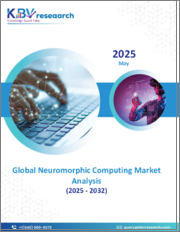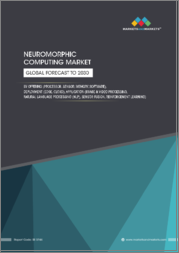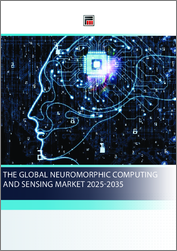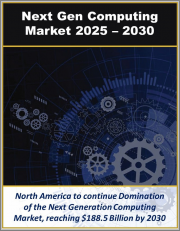
|
시장보고서
상품코드
1776691
세계의 뉴로모픽 컴퓨팅 시장 : 예측 - 컴포넌트별, 전개별, 용도별, 최종 사용자별, 지역별 분석(-2032년)Neuromorphic Computing Market Forecasts to 2032 - Global Analysis By Component (Hardware and Software), Deployment (Edge Computing and Cloud Computing), Application, End User and By Geography |
||||||
Stratistics MRC에 따르면 세계의 뉴로모픽 컴퓨팅 시장은 2025년에 82억 9,000만 달러로 추정되고, 예측 기간 동안 CAGR 20.23%로 성장할 전망이며, 2032년에는 301억 2,000만 달러에 이를 것으로 예측됩니다.
뉴로모픽 컴퓨팅은 인간의 뇌의 구성과 동작을 시뮬레이션함으로써 기존의 컴퓨팅 시스템보다 효율적으로 정보를 처리하는 신기술입니다. 신경망이나 뇌와 같은 아키텍처에 착상을 얻은 신경망 시스템에서는 메모리 스타나 스파이킹 신경망과 같은 특수한 하드웨어를 사용함으로써 소비 전력을 대폭 억제하면서 고속 계산이 가능해집니다. 이 방식은 패턴 인식, 감각 데이터 처리, 적응 학습을 필요로 하는 작업이 뛰어나기 때문에 로봇 공학, 에지 컴퓨팅, 인공 지능 애플리케이션에 매우 적합합니다. 아울러 뉴로모픽 컴퓨팅은 에너지 효율이 높은 AI 솔루션에 대한 수요 증가에 대응하기 위해 차세대 지능형 시스템을 향한 혁명적인 단계로 주목받고 있습니다.
Neuromorphic Computing and Engineering 잡지에 게재된 2022년 IBM 주도의 로드맵에 의하면, 뉴로모픽 시스템은 종래의 폰 노이만 아키텍쳐보다 소비 전력이 대폭 낮고, 수백 메가와트가 아니라 불과 20-30 메가와트로 엑서스케일 레벨의 컴퓨팅이 가능하게 될 가능성이 있습니다.
소비 전력이 적은 AI 하드웨어에 대한 요구 증가
전통적인 AI 모델, 특히 엄청난 에너지 및 처리 능력을 필요로 하는 딥러닝 아키텍처를 실행하려면 대규모 데이터센터가 자주 필요합니다. 뉴로모픽 컴퓨팅은 적은 에너지로 정보를 처리하는 뇌의 능력에서 힌트를 얻어 패러다임 전환을 제공합니다. IBM의 True North나 인텔의 Loihi와 같은 칩은, 큰폭으로 적은 전력으로 복잡한 계산을 실행하도록 만들어져 있습니다. 게다가 웨어러블, 드론, 모바일 로봇 등 인텔리전스를 해치지 않으면서 효율성을 중시하는 배터리가 한정된 애플리케이션에 최적입니다.
표준화된 프로그래밍 모델 및 아키텍처 부재
잘 알려진 폰 노이먼과 하버드 아키텍처를 준수하는 기존의 컴퓨팅 시스템과는 달리, 뉴로모픽 컴퓨팅에는 프로그래밍 모델, 소프트웨어 인터페이스 및 하드웨어 설계에 대한 업계 표준이 없습니다. 사용자 정의 학습 알고리즘, 컴파일러, 툴체인은 칩마다 자주 필요합니다. 이러한 단편화가 가져오는 호환성 문제는 개발자나 시스템 통합자에게 확장 가능하고 휴대용인 애플리케이션을 만드는 것을 어렵게 만들고 있습니다. 게다가 단일 에코 시스템이 확립되기 전까지는 채용은 연구 환경이나 특수한 애플리케이션에 계속 한정될 것으로 생각됩니다.
신경기술 및 브레인 머신 인터페이스(BMI) 개발
뉴로모픽 컴퓨팅은 생물학적 뿌리에서 신경과학 용도 분야, 특히 뉴로프로스테틱과 브레인 머신 인터페이스에 적합합니다. EEG나 EMG 같은 생체신호를 실시간으로 처리할 수 있기 때문에 인간과 컴퓨터의 상호작용이 더 자연스러워집니다. 장애인 지원 기술에서 마인드 컨트롤 휠체어, 로봇 팔다리, 커뮤니케이션 장치의 가능성은 특히 유망합니다. 뉴로테크놀로지와 생물의학 공학이 진보함에 따라 뉴로몰픽 플랫폼은 저전력과 대기시간으로 복잡한 뇌 신호를 해독하기 위한 완벽한 계산 기반을 제공합니다.
유명한 AI 하드웨어 기술과의 경쟁
뉴로모픽 컴퓨팅은 GPU, TPU, FPGA, 심지어는 커스텀 ASIC과 같은 유명한 AI 가속기와의 치열한 경쟁이 있습니다. 이러한 플랫폼은 딥러닝이나 추론 등의 AI 태스크에서 확립된 성능을 가지고 있으며, 에코 시스템 및 견고한 개발자 지원을 개발하고 있습니다. 구글이나 엔비디아 같은 기업도 소비전력을 억제한 새롭고 개량된 AI 칩을 항상 발표하고 있습니다. 소프트웨어 호환성과 인프라에 대한 투자가 현재 플랫폼에서 이미 이뤄지고 있다는 점을 감안하면 뉴로모픽 시스템의 장점은 기존 AI 하드웨어의 급속한 발전으로 인해 가려질 수 있습니다.
COVID-19의 영향 :
COVID-19의 유행은 뉴로모픽 컴퓨팅 시장에 다양한 영향을 주었습니다. 단기적으로는 반도체 생산 지연, 연구개발 예산 감소, 글로벌 공급망 혼란이 하드웨어 개발에 방해가 돼 상업 전개 속도를 늦췄습니다. 하지만 팬데믹은 디지털 전환을 가속화시켰고, 특히 엣지 AI 애플리케이션, 헬스케어, 원격 모니터링에 있어 로컬에서 데이터를 처리할 수 있는 지능적이고 에너지 효율적인 시스템의 필요성에 주목을 받았습니다. 이러한 변화 때문에 현재는 저전력 실시간 처리 솔루션으로서 뉴로모픽 컴퓨팅에 대한 관심이 높아지고 있습니다. 이 때문에 초기의 진보는 늦었다고는 하지만 팬데믹 후의 환경이 뉴로모픽 기술에 대한 연구와 투자를 뒷받침하고 있습니다.
예측 기간 동안 이미지 처리 부문이 최대가 될 전망
예측 기간 동안 최대 시장 점유율을 차지할 것으로 예상되는 것은 이미지 처리 분야입니다. 이 우위성은 뉴로모픽 아키텍처가 이벤트 구동형 병렬 계산을 통해 고속의 시각 데이터를 효율적으로 처리함으로써 인간의 시각야와 흡사한 능력을 발휘하는 것에 기인합니다. 자율주행차, 모니터링 시스템, 의료용 영상 처리 등 실시간 영상 인식과 분류를 필요로 하는 애플리케이션은 뉴로모픽 시스템의 저전력 및 전광석화 반응 시간으로부터 큰 혜택을 받고 있습니다. 이미지 처리는 기존 기술보다 효율, 속도, 확장성이 높기 때문에 에지 컴퓨팅 및 스마트 비전 시스템의 급속한 성장에도 불구하고 지속적으로 시장을 독점하고 있습니다.
예측 기간 중 자동차 분야가 가장 높은 CAGR이 예상
예측 기간 중 자동차 분야가 가장 높은 성장률을 보일 것으로 예측됩니다. 자율 주행차나 ADAS(선진 운전 지원 시스템)의 이용이 확대되고 있어 대량의 감각 데이터를 극히 낮은 레이턴시와 소비 전력으로 실시간 처리하는 것이 요구되고 있는 것이, 이 급확대의 주된 요인입니다. 이벤트 구동형 뇌와 같은 아키텍처를 가진 뉴로모픽 칩은 시간 제약이 있는 운전 상황에서 안전하고 에너지 효율적인 의사결정을 촉진하는 데 최적입니다. 게다가 뉴로모픽 프로세서는, 자동차 업계가 서서히 레벨 5의 자율성과 V2X(Vehicle-to-Everything) 통신으로 이행해 가는 가운데, 차세대의 스마트카를 형성하는 데 있어서 지극히 중요한 역할을 완수할 것으로 예상되고 있습니다.
최대 공유 지역 :
예측 기간 동안 북미가 가장 큰 시장 점유율을 차지할 것으로 예측됩니다. 이것은 최첨단 컴퓨팅 기술에 대한 대규모 투자와 BrainChip, IBM, Intel과 같은 대기업의 견고한 존재에 의한 것입니다. 국방연구, 인공지능, 뇌를 이용한 컴퓨팅을 중심으로 한 학술 프로젝트에 대한 왕성한 자금 제공은 이 지역에 유리합니다. 게다가 뉴로모픽 하드웨어의 요구는 북미가 가전, 헬스케어, 자동차, 항공우주 등의 산업에서 재빨리 AI를 도입한 것에 의해서 지탱되고 있습니다. 특히 미국은 정부가 지원하는 이니셔티브와 민간 부문의 혁신을 통해 뉴로모픽 연구 개발을 선도하고 있으며, 이 지역은 기술 개발 및 시장 수익 점유율 모두에서 압도적인 강세를 자랑하고 있습니다.
CAGR이 가장 높은 지역 :
예측 기간 동안 아시아태평양이 가장 높은 CAGR을 나타낼 것으로 예측됩니다. 급속한 기술 진보, 로봇공학과 인공지능에 대한 투자 증가, 중국, 일본, 한국, 인도 등의 국가에서 반도체 기술 혁신에 대한 정부의 강력한 지원이 이 성장의 주요 원동력입니다. 에너지 효율이 높은 실시간 컴퓨팅 솔루션 수요가 높은 것은 이 지역의 전자기기 제조 기반이 확대되고 가전, 산업 자동화, 자동차에서 스마트 기술 이용이 확대되고 있기 때문이다. 더욱이 뉴로몰픽 시스템의 학술적 및 상업적 연구 확대로 차세대 AI 하드웨어 개발의 세계적 중심지로서의 아시아태평양의 대두가 가속화되고 있습니다.
사용자 정의 무료 제공 :
이 보고서를 구독하는 고객은 다음 무료 맞춤설정 옵션 중 하나를 사용할 수 있습니다.
- 기업 프로파일
- 추가 시장 기업의 종합적 프로파일링(3개사까지)
- 주요 기업의 SWOT 분석(3개사까지)
- 지역 세분화
- 고객의 관심에 응한 주요국 시장 추계, 예측 및 CAGR(주 : 타당성 확인에 따름)
- 경쟁 벤치마킹
- 제품 포트폴리오, 지리적 존재, 전략적 제휴에 기반한 주요 기업 벤치마킹
목차
제1장 주요 요약
제2장 서문
- 개요
- 이해관계자
- 조사 범위
- 조사 방법
- 데이터 마이닝
- 데이터 분석
- 데이터 검증
- 조사 접근
- 조사 자료
- 1차 조사 자료
- 2차 조사 정보원
- 전제조건
제3장 시장 동향 분석
- 성장 촉진요인
- 성장 억제요인
- 기회
- 위협
- 용도 분석
- 최종 사용자 분석
- 신흥 시장
- COVID-19의 영향
제4장 Porter's Five Forces 분석
- 공급기업의 협상력
- 구매자의 협상력
- 대체품의 위협
- 신규 참가업체의 위협
- 경쟁 기업간 경쟁 관계
제5장 세계의 뉴로모픽 컴퓨팅 시장 : 컴포넌트별
- 하드웨어
- 소프트웨어
제6장 세계의 뉴로모픽 컴퓨팅 시장 : 전개별
- 엣지 컴퓨팅
- 클라우드 컴퓨팅
제7장 세계의 뉴로모픽 컴퓨팅 시장 : 용도별
- 신호 처리
- 화상 처리
- 데이터 처리
- 물체 검출
- 기타 용도
제8장 세계의 뉴로모픽 컴퓨팅 시장 : 최종 사용자별
- 가전
- 자동차
- 항공우주 및 방위
- 헬스케어
- IT 및 통신
- 산업
- 기타 최종 사용자
제9장 세계의 뉴로모픽 컴퓨팅 시장 : 지역별
- 북미
- 미국
- 캐나다
- 멕시코
- 유럽
- 독일
- 영국
- 이탈리아
- 프랑스
- 스페인
- 기타 유럽
- 아시아태평양
- 일본
- 중국
- 인도
- 호주
- 뉴질랜드
- 한국
- 기타 아시아태평양
- 남미
- 아르헨티나
- 브라질
- 칠레
- 기타 남미
- 중동 및 아프리카
- 사우디아라비아
- 아랍에미리트(UAE)
- 카타르
- 남아프리카
- 기타 중동 및 아프리카
제10장 주요 발전
- 계약, 파트너십, 협업 및 합작투자
- 인수 및 합병
- 신제품 발매
- 사업 확대
- 기타 주요 전략
제11장 기업 프로파일링
- Intel Corporation
- HRL Laboratories, LLC
- GrAI Matter Labs
- IBM Corporation
- Qualcomm Technologies, Inc.
- Micron Technology Inc
- BrainChip Holdings Ltd.
- Hewlett Packard Enterprise(HPE)
- Samsung Electronics Co. Ltd
- Knowm Inc.
- General Vision Inc.
- SK Hynix Inc.
- Vicarious FPC Inc.
- Nepes Corporation
- Gyrfalcon Technology Inc.
- SynSense AG
According to Stratistics MRC, the Global Neuromorphic Computing Market is accounted for $8.29 billion in 2025 and is expected to reach $30.12 billion by 2032 growing at a CAGR of 20.23% during the forecast period. Neuromorphic computing is a new technology that processes information more effectively than conventional computing systems by simulating the composition and operations of the human brain. The use of specialized hardware, such as memristors and spiking neural networks, in neuromorphic systems, which are inspired by neural networks and brain-like architectures, allows for faster computation with much lower power consumption. This method is perfect for applications in robotics, edge computing, and artificial intelligence since it excels at tasks requiring pattern recognition, sensory data processing, and adaptive learning. Moreover, neuromorphic computing is gaining traction as a revolutionary step toward next-generation intelligent systems to meet the growing demand for energy-efficient AI solutions.
According to a 2022 IBM-led roadmap published in Neuromorphic Computing and Engineering, neuromorphic systems offer significantly lower power consumption than traditional von-Neumann architectures-potentially enabling exascale-level computing at only 20-30 MW instead of hundreds of megawatts.
Market Dynamics:
Driver:
Growing need for AI hardware that uses less energy
Large data centers are frequently needed to run traditional AI models, particularly deep learning architectures, which demand enormous amounts of energy and processing power. Neuromorphic computing offers a paradigm shift, drawing inspiration from the brain's capacity to process information with little energy. Chips such as IBM's True North and Intel's Loihi are made to carry out intricate calculations with significantly less power usage. Additionally, this makes them perfect for battery-limited applications where efficiency is essential without compromising intelligence, like wearable's, drones, and mobile robots.
Restraint:
Absence of standardized programming models and architecture
Neuromorphic computing does not have industry-wide standards for programming models, software interfaces, or hardware design, in contrast to traditional computing systems that adhere to well-known von Neumann or Harvard architectures. Custom learning algorithms, compilers, and toolchains are frequently needed for each chip. Compatibility problems brought on by this fragmentation make it challenging for developers and system integrators to create scalable and portable applications. Furthermore, adoption will continue to be restricted to research settings and specialized applications until a single ecosystem is established.
Opportunity:
Developments in neurotechnology and brain-machine interfaces (BMIs)
Due to its biological roots, neuromorphic computing is well suited for neuroscience applications, particularly neuroprosthetics and brain-machine interfaces. Because it can process bio-signals like EEG or EMG in real time, human-computer interaction can become more natural. The potential for mind-controlled wheelchairs, robotic limbs, and communication devices in assistive technologies for individuals with disabilities is particularly encouraging. As neurotechnology and biomedical engineering advance, neuromorphic platforms provide the perfect computational basis for decoding intricate brain signals with low power consumption and latency.
Threat:
Rivalry with well-known ai hardware technologies
There is fierce competition for neuromorphic computing from well-known AI accelerators such as GPUs, TPUs, FPGAs, and even custom ASICs. These platforms have established performance in AI tasks like deep learning and inference, as well as developed ecosystems and robust developer support. Companies like Google and NVIDIA are also constantly coming up with new and improved AI chips that use less power. Given that software compatibility and infrastructure investments are already in place for current platforms, the perceived advantages of neuromorphic systems could be overshadowed by the quick advancements in conventional AI hardware.
Covid-19 Impact:
The COVID-19 pandemic affected the neuromorphic computing market in a variety of ways. In the near term, delays in semiconductor production, diminished R&D budgets, and disruptions in global supply chains hindered hardware development and slowed the rate of commercial deployment. However, the pandemic also sped up digital transformation and brought attention to the need for intelligent, energy-efficient systems that can process data locally, particularly in edge AI applications, healthcare, and remote monitoring. Because of this change, there is now more interest in neuromorphic computing as a low-power, real-time processing solution. Because of this, even though early advancements were delayed, the post-pandemic environment has encouraged more research and investment in neuromorphic technologies.
The image processing segment is expected to be the largest during the forecast period
The image processing segment is expected to account for the largest market share during the forecast period. This dominance is explained by the neuromorphic architecture's capacity to closely resemble the human visual cortex by processing high-speed visual data efficiently through event-driven, parallel computation. Applications that require real-time image recognition and classification, like autonomous cars, surveillance systems, and medical imaging, greatly benefit from neuromorphic systems' low power consumption and lightning-fast reaction times. Since image processing offers greater efficiency, speed, and scalability than conventional techniques, it continues to dominate the market despite the quick growth of edge computing and smart vision systems.
The automotive segment is expected to have the highest CAGR during the forecast period
Over the forecast period, the automotive segment is predicted to witness the highest growth rate. The growing use of autonomous vehicles and advanced driver-assistance systems (ADAS), which demand real-time processing of large amounts of sensory data with extremely low latency and power consumption, is the main driver of this quick expansion. With their event-driven, brain-like architectures, neuromorphic chips are perfect for facilitating safe, energy-efficient decision-making in situations involving time-sensitive driving. Moreover, neuromorphic processors are anticipated to be crucial in forming the next generation of smart cars as the automotive industry gradually transitions to Level 5 autonomy and vehicle-to-everything (V2X) communication.
Region with largest share:
During the forecast period, the North America region is expected to hold the largest market share, driven by large investments in cutting-edge computing technologies and the robust presence of major players like BrainChip, IBM, and Intel. Strong funding for defense research, artificial intelligence, and academic projects centered on brain-inspired computing is advantageous to the area. Furthermore, the need for neuromorphic hardware is supported by North America's early adoption of AI in industries like consumer electronics, healthcare, automotive, and aerospace. Through government-supported initiatives and private sector innovation, the U.S. in particular leads in neuromorphic R&D, making the region a dominant force in both technological development and market revenue share.
Region with highest CAGR:
Over the forecast period, the Asia-Pacific region is anticipated to exhibit the highest CAGR. Rapid technological advancements, rising investments in robotics and artificial intelligence, and robust government support for semiconductor innovation in nations like China, Japan, South Korea, and India are the main drivers of this growth. Energy-efficient, real-time computing solutions are in high demand due to the region's growing electronics manufacturing base and the growing use of smart technologies in consumer electronics, industrial automation, and automotive. Additionally, Asia-Pacific's rise as a global center for the development of next-generation AI hardware is being accelerated by the expansion of both academic and commercial research in neuromorphic systems.
Key players in the market
Some of the key players in Neuromorphic Computing Market include Intel Corporation, HRL Laboratories, LLC, GrAI Matter Labs, IBM Corporation, Qualcomm Technologies, Inc., Micron Technology Inc, BrainChip Holdings Ltd., Hewlett Packard Enterprise (HPE), Samsung Electronics Co. Ltd, Knowm Inc., General Vision Inc., SK Hynix Inc., Vicarious FPC Inc., Nepes Corporation, Gyrfalcon Technology Inc. and SynSense AG.
Key Developments:
In May 2025, Qualcomm Technologies, Inc. and Xiaomi Corporation are celebrating 15 years of collaboration and have executed a multi-year agreement. The relationship between Qualcomm Technologies and Xiaomi has been pivotal in driving innovation across the technology industry and the companies are committed to delivering industry-leading products and solutions across various device categories globally.
In April 2025, HRL Laboratories, LLC has officially opened its new advanced research and manufacturing facility in Camarillo, California, marking a significant milestone in the company's commitment to innovation in infrared (IR) hardware. The 60,000-square-foot facility, housing state-of-the-art labs, cleanrooms, high-bay and office space, dramatically enhances HRL's fabrication and in-house testing capabilities.
In April 2025, Intel Corporation announced that it has entered into a definitive agreement to sell 51% of its Altera business to Silver Lake, a global leader in technology investing. The transaction, which values Altera at $8.75 billion, establishes Altera's operational independence and makes it the largest pure-play FPGA semiconductor solutions company. Altera offers a proven and highly scalable architecture and tool chain and is focused on driving growth and FPGA innovation to meet the demands and opportunities of an AI-driven market.
Components Covered:
- Hardware
- Software
Deployments Covered:
- Edge Computing
- Cloud Computing
Applications Covered:
- Signal Processing
- Image Processing
- Data Processing
- Object Detection
- Other Applications
End Users Covered:
- Consumer Electronics
- Automotive
- Aerospace & Defense
- Healthcare
- IT & Telecom
- Industrial
- Other End Users
Regions Covered:
- North America
- US
- Canada
- Mexico
- Europe
- Germany
- UK
- Italy
- France
- Spain
- Rest of Europe
- Asia Pacific
- Japan
- China
- India
- Australia
- New Zealand
- South Korea
- Rest of Asia Pacific
- South America
- Argentina
- Brazil
- Chile
- Rest of South America
- Middle East & Africa
- Saudi Arabia
- UAE
- Qatar
- South Africa
- Rest of Middle East & Africa
What our report offers:
- Market share assessments for the regional and country-level segments
- Strategic recommendations for the new entrants
- Covers Market data for the years 2024, 2025, 2026, 2028, and 2032
- Market Trends (Drivers, Constraints, Opportunities, Threats, Challenges, Investment Opportunities, and recommendations)
- Strategic recommendations in key business segments based on the market estimations
- Competitive landscaping mapping the key common trends
- Company profiling with detailed strategies, financials, and recent developments
- Supply chain trends mapping the latest technological advancements
Free Customization Offerings:
All the customers of this report will be entitled to receive one of the following free customization options:
- Company Profiling
- Comprehensive profiling of additional market players (up to 3)
- SWOT Analysis of key players (up to 3)
- Regional Segmentation
- Market estimations, Forecasts and CAGR of any prominent country as per the client's interest (Note: Depends on feasibility check)
- Competitive Benchmarking
- Benchmarking of key players based on product portfolio, geographical presence, and strategic alliances
Table of Contents
1 Executive Summary
2 Preface
- 2.1 Abstract
- 2.2 Stake Holders
- 2.3 Research Scope
- 2.4 Research Methodology
- 2.4.1 Data Mining
- 2.4.2 Data Analysis
- 2.4.3 Data Validation
- 2.4.4 Research Approach
- 2.5 Research Sources
- 2.5.1 Primary Research Sources
- 2.5.2 Secondary Research Sources
- 2.5.3 Assumptions
3 Market Trend Analysis
- 3.1 Introduction
- 3.2 Drivers
- 3.3 Restraints
- 3.4 Opportunities
- 3.5 Threats
- 3.6 Application Analysis
- 3.7 End User Analysis
- 3.8 Emerging Markets
- 3.9 Impact of Covid-19
4 Porters Five Force Analysis
- 4.1 Bargaining power of suppliers
- 4.2 Bargaining power of buyers
- 4.3 Threat of substitutes
- 4.4 Threat of new entrants
- 4.5 Competitive rivalry
5 Global Neuromorphic Computing Market, By Component
- 5.1 Introduction
- 5.2 Hardware
- 5.3 Software
6 Global Neuromorphic Computing Market, By Deployment
- 6.1 Introduction
- 6.2 Edge Computing
- 6.3 Cloud Computing
7 Global Neuromorphic Computing Market, By Application
- 7.1 Introduction
- 7.2 Signal Processing
- 7.3 Image Processing
- 7.4 Data Processing
- 7.5 Object Detection
- 7.6 Other Applications
8 Global Neuromorphic Computing Market, By End User
- 8.1 Introduction
- 8.2 Consumer Electronics
- 8.3 Automotive
- 8.4 Aerospace & Defense
- 8.5 Healthcare
- 8.6 IT & Telecom
- 8.7 Industrial
- 8.8 Other End Users
9 Global Neuromorphic Computing Market, By Geography
- 9.1 Introduction
- 9.2 North America
- 9.2.1 US
- 9.2.2 Canada
- 9.2.3 Mexico
- 9.3 Europe
- 9.3.1 Germany
- 9.3.2 UK
- 9.3.3 Italy
- 9.3.4 France
- 9.3.5 Spain
- 9.3.6 Rest of Europe
- 9.4 Asia Pacific
- 9.4.1 Japan
- 9.4.2 China
- 9.4.3 India
- 9.4.4 Australia
- 9.4.5 New Zealand
- 9.4.6 South Korea
- 9.4.7 Rest of Asia Pacific
- 9.5 South America
- 9.5.1 Argentina
- 9.5.2 Brazil
- 9.5.3 Chile
- 9.5.4 Rest of South America
- 9.6 Middle East & Africa
- 9.6.1 Saudi Arabia
- 9.6.2 UAE
- 9.6.3 Qatar
- 9.6.4 South Africa
- 9.6.5 Rest of Middle East & Africa
10 Key Developments
- 10.1 Agreements, Partnerships, Collaborations and Joint Ventures
- 10.2 Acquisitions & Mergers
- 10.3 New Product Launch
- 10.4 Expansions
- 10.5 Other Key Strategies
11 Company Profiling
- 11.1 Intel Corporation
- 11.2 HRL Laboratories, LLC
- 11.3 GrAI Matter Labs
- 11.4 IBM Corporation
- 11.5 Qualcomm Technologies, Inc.
- 11.6 Micron Technology Inc
- 11.7 BrainChip Holdings Ltd.
- 11.8 Hewlett Packard Enterprise (HPE)
- 11.9 Samsung Electronics Co. Ltd
- 11.10 Knowm Inc.
- 11.11 General Vision Inc.
- 11.12 SK Hynix Inc.
- 11.13 Vicarious FPC Inc.
- 11.14 Nepes Corporation
- 11.15 Gyrfalcon Technology Inc.
- 11.16 SynSense AG



















